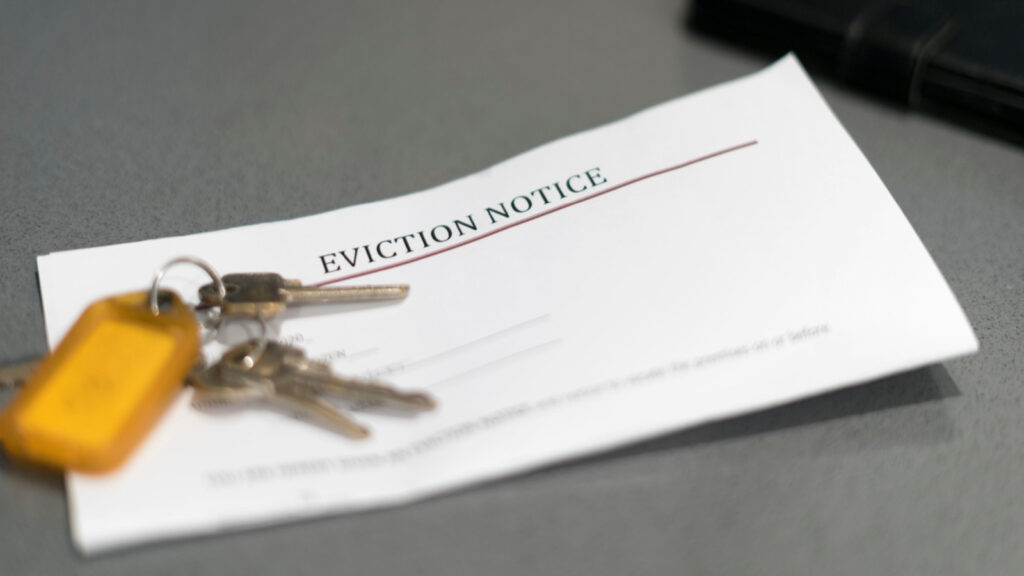Evicting a tenant can be fraught with complexity – and with the Renters Reform Bill proposing to make more changes to the process, it’s never been more important for landlords to correctly follow procedures.
“As the Renter’s Reform Bill comes into play, section 21 so called ‘no fault’ evictions will be banned,” advises Rob Smith, Managing Director of Whitegates.
“Notice periods for renting will double and a tenancy can only end if a renter requests it, or a landlord has a valid reason, which can be defined in law, eg. they have not paid rent, are engaging in anti-social behaviour or you have a ‘break clause’ in your contract.
“It’s really important to correctly follow procedures and give the correct notice periods no matter how frustrating the situation is.”
In this guide, we explain how to evict a tenant and regain possession of your rental property correctly and legally.
We also explore the potential changes proposed by the Renters Reform Bill.
Can a landlord just evict a tenant?
You can only evict a tenant during their fixed term if you have grounds to do so, or if there is an agreed break clause in your tenancy agreement.
If your tenant’s fixed term is at an end, or they are renting on a periodic tenancy, you can give them notice that you wish to regain possession of your property without providing a reason.
The process of evicting a tenant
Evicting a tenant is a legal process and must be carried out properly.
If you have an assured shorthold tenancy agreement with your tenant, you need to know if your agreement is:
- A fixed term tenancy agreement
- A periodic tenancy agreement
A fixed term agreement runs for a certain agreed period of time, while a periodic tenancy runs either week by week or month by month with no end date.
Periodic tenancies usually occur when a fixed term agreement expires and is not renewed.
Once you’ve established the type of agreement you have with your tenant, there are two possible processes you can use to regain possession of your property:
1. A section 21 notice
Also known as ‘no fault evictions’, you can issue your tenant with a section 21 notice under the Housing Act 1988 if their fixed term is ending or you have an agreed break clause in place.
Section 21 notices don’t require the court’s involvement, so can be a more effective way of regaining possession of your property even if you also have grounds for eviction.
To issue your tenant with a section 21 notice of possession, you must have:
- Protected your tenant’s deposit in one of the government’s approved tenancy deposit protection schemes within 30 days of receiving it
- Given your tenant a copy of your property’s latest gas safety certificate and Energy Performance Certificate (EPC)
- Given your tenant a copy of the government’s How to Rent guide, alongside prescribed information on the property, the landlord, and the scheme their deposit if protected in
- Not received an improvement notice from the local authority under the Housing Health and Safety Rating System (HHSRS) within the previous six months
- Not retained any unlawful tenant fees under the Tenant Fees Act 2019
Section 21 notices can’t be issued during the first four months of a tenancy agreement and are only valid for six months.
You must provide your tenant with at least two months’ notice when issuing a section 21 notice and your required date of possession can’t be earlier than the final date of the fixed term tenancy unless stated in your tenancy agreement.
2. A section 8 notice
A section 8 notice under the Housing Act 1988 can be used if you have grounds to evict your tenant during their fixed term.
Section 8 grounds for possession include mandatory grounds, where the court must grant you possession if proven, and discretionary grounds where the final decision lies with a judge.
Grounds for possession include:
- Rent arrears
- Tenant anti-social behaviour
- Property damage caused by the tenant
3. Make a possession order
If your tenant leaves after being served a section 21 notice, or after a court grants you possession under section 8, the eviction process is over, and you have possession of your property.
If they refuse to leave after being served either notice, you can issue a possession order.
There are two types of possession order:
1. Accelerated possession
If you issue your tenant with a section 21 notice and they fail to leave by the date specified, you can use an accelerated possession order.
Accelerated possession orders can’t be used if you’re claiming rent arrears, as there is no court hearing.
Instead, you complete the N5B form and pay a fee, and the court will forward the possession application to the tenant, who has 14 days to object if they wish.
When there’s no objection from the tenant, the court will grant an order for possession, which includes the tenant covering the court fee.
If the tenant does object, you may have to have a court hearing.
2. Standard possession
Standard possession claims can be used if your tenant has not moved out by the date specified in a section 8 or section 21 notice and you wish to make a claim for unpaid rent.
To start standard possession proceedings, you should fill out the N5 form and N119 form if you’re claiming rent arrears.
On what grounds can a landlord evict a tenant?
In the UK, section 8 includes mandatory grounds, where a judge must grant possession if proven, and discretionary grounds where the judge’s decision is final.
Mandatory grounds for possession include:
- You wish to occupy your rental property as your main home
- When the tenant is in rental arrears
Discretionary grounds for possession include:
- When the tenant has consistently delayed paying their rent, even if they’re not in arrears
- When the tenant has broken the other terms of the tenancy agreement besides payment of rent
- When the tenant has caused damage to the property or your furnishings
- When the tenant is causing a nuisance to others or using the property for illegal practices
- When the tenant is found to have made false statements on their tenancy application
Notice periods for section 8 grounds vary, and you’ll need to ensure you give the correct notice for the ground you’re claiming:
|
Section ground for possession |
Required notice period |
|
You want to move into the property |
Two months |
|
Your property is being repossessed |
Two months |
|
The property is being demolished or redeveloped |
Two months |
|
The tenant has displayed serious anti-social behaviour |
Four weeks (periodic tenancy), one month (fixed term) |
|
The tenant has no right to rent in the UK |
Two weeks |
|
The tenant is in serious rent arrears |
Two weeks |
|
The tenant has made consistent late rent payments |
Two weeks |
|
The tenant is in breach of their agreement |
Two weeks |
|
The tenant has used the property for illegal purposes |
None |
How long does it take to evict a tenant?
The length of time it takes to evict a tenant varies depending on:
- Whether you’ve issued a section 21 or section 8 notice
- Your ground for possession under 8
- Whether the tenant leaves on the date specified, or you need to make a possession order
If you’ve issued your tenant with a section 21 notice, they have two months to leave the property.
Section 8 notice periods, however, vary from no notice at all to two months, depending on the ground for possession you’re claiming.
If you’re forced to issue a possession order, it can take six to 10 weeks from the date the proceedings start to an order for possession being issued by the court.
In cases where a tenant still refuses to leave after a possession order is issued, bailiffs will need to be instructed, which could take a further four-to-six weeks.
Who pays court costs for an eviction?
If you go to court to obtain a possession order, you’ll need to pay any up-front costs to the court.
However, if the judge issues a possession order with costs, you will be able to recover some of these up-front expenses from your tenant.
How do I evict a tenant without going to court?
If your tenant’s fixed term has ended or is coming to an end, you can use a section 21 notice without the need for a court hearing.
Should your tenant fail to leave by the date specified in the notice, and if you’re not claiming rent arrears, you can apply for an accelerated possession without going to court.
Can you evict a tenant to sell your house?
If you wish to sell your rental property, you can only evict your tenant with a section 21 notice if their fixed term has ended, is coming to an end, or if they on renting on a periodic tenancy.
There is no section 8 ground for possession if you wish to sell your property.
Evictions and the Renters Reform Bill
The Renters Reform Bill includes major changes to the private rented sector, including to the way evictions are carried out.
The Bill proposes to:
- Abolish section 21 ‘no fault’ evictions
- Abolish fixed term tenancies
- Widen grounds for possession under section 8
Should section 21 be removed, you would need to use a section 8 notice to regain possession of your property.
However, the Bill also proposes to make most section 8 grounds mandatory, meaning a judge would have to rule in a landlord’s favour should the ground they’re claiming be proven.
A ground for landlords who wish to sell their property, or move their family in, would also be added.




